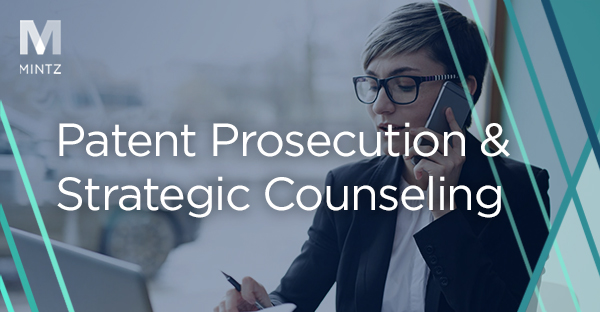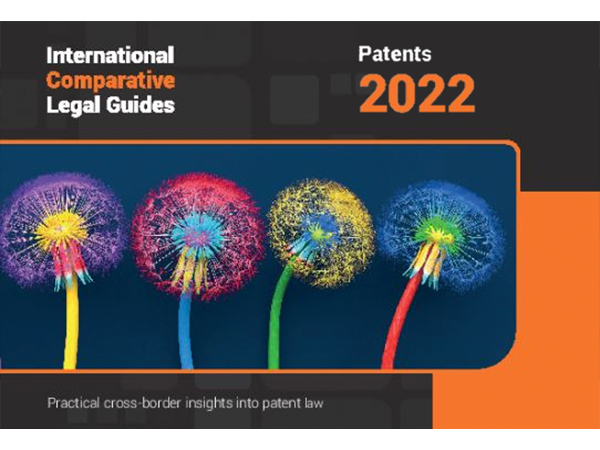
Intellectual Property
Viewpoints
Filter by:
Patent Owner Tip #17 for Surviving an Instituted IPR: Alternatives to Motions to Amend in IPR Proceedings
September 2, 2021 | Blog | By Peter Cuomo, Monique Winters Macek
After an inter partes review (“IPR”) is instituted, a patent owner may move to amend challenged claims to overcome the prior art. Here we provide some further information for patent owners considering ways to amend claims that are challenged in IPR by filing a reissue application or requesting reexamination.
Read more
Nonobviousness of Commercially Successful Designs: Mmm, Mmm, Not So Fast
August 31, 2021 | Blog | By Adam Samansky, Peter Cuomo, Serge Subach
Patent Owner Tip #16 for Surviving an Instituted IPR: Improve Your Chances of Getting Amendments
August 26, 2021 | Blog | By William Meunier, Courtney Herndon
Here are four tips for improving your chances of convincing PTAB to grant a motion to amend your claims.
Read more
PTAB statistics show interesting trends for Orange Book and biologic patents in AIA proceedings
August 24, 2021 | Blog | By Peter Cuomo, Joe Rutkowski, Nana Liu
The PTAB recently published the first update to its 2019 study of AIA trials involving petitions challenging Orange Book-listed patents and biologic patents through June 2021. Highlights of these pharmaceutical patent challenge statistics include, e.g., the number of these petitions filed, the number of instituted trials, and the trial outcomes since fiscal year 2013.
Read more
Patent Owner Tip #15 for Surviving an Instituted IPR: Procedure for Motions to Amend
August 19, 2021 | Blog | By Daniel Weinger, Nana Liu
See the guidelines on the procedural aspects of filing a motion to amend claims.
Read more
Patent Owner Tip #14 for Surviving an Instituted IPR: When Not to Amend Claims in an IPR
August 12, 2021 | Blog | By Brad M Scheller, Sean Casey
We look to those circumstances when a patent owner should think twice about amending, including when significant past damages exist, the current claims possess strong infringement reads and claim scope, petitioners are highly-motivated to fight and patent owner is cost sensitive.
Read more
AI in Biotech and Synthetic Biology: What Can Be Protected? What Should Be Kept Secret?
August 11, 2021 | Blog | By Joshua Berk, Terri Shieh-Newton
Machine learning (ML), bioinformatics, artificial intelligence (AI), and other computational tools have become ubiquitous in the biotech and synthetic biology industries because such technology allows for rapid processing of a large amount of complex data to produce advancements in therapeutics and diagnostics. As the landscape becomes increasingly more competitive, it is important for companies, particularly in the aforementioned industries, to obtain patent protection for their AI-related technology.
Read more
Patent Owner Tip #13 for Surviving an Instituted IPR: When to Amend Claims in an IPR
August 6, 2021 | Blog | By Monique Winters Macek, Michael Newman
After an inter partes review (“IPR”) is instituted, a patent owner has an opportunity to file a motion to amend the claims and thereby propose a reasonable number of substitute claims. Here we provide some instances where a motion to amend may be a favorable option for a patent owner to consider.
Read more
Federal Circuit Reminds the PTAB that the APA Process Still Matters
August 3, 2021 | Blog | By Daniel Weinger, Laura Petrasky
The Federal Circuit recently found that the Patent Trial and Appeal Board (“Board”) violates a patent owner’s procedural rights under the Administrative Procedure Act (“APA”) when construing a disputed claim term by omitting an uncontested requirement in its construction.
Read more
Patent Owner Tip #12 for Surviving an Instituted IPR: Address Individual Claims – Dependent Claims Can Save the Day
July 29, 2021 | Blog | By Peter Cuomo, Nana Liu
In inter partes review (IPR) proceedings, the PTAB will often uphold the validity of dependent claims despite finding the independent claim invalid. Dependent claims recite additional limitations that must be separately accounted for in the prior art references in the Petitioner’s asserted grounds.
Read more
The USPTO’s Patent Classification and Search Systems Have Jumped on the AI Bandwagon
July 8, 2021 | Blog | By Christina Sperry, Amanda Metell
It is no question that Artificial Intelligence (“AI”) technologies have popped up in all aspects of society such as online shopping, music streaming, and social networking. The U.S. Patent and Trademark Office (“USPTO”) has even reported that patents which incorporate AI has increased from under 5% in 1980 to over 20% in 2018. Among those organizations that utilize AI is the USPTO itself.
Read more
PATENT 101: Key Considerations and Activities for Establishing a Patent Program (Part 1 of 3)
July 7, 2021 | Blog | By Michael Van Loy, Kevin Amendt, Nicholas Eadie
Tasked with starting an innovation protection and patent development program at your company but do not know where to begin? This three part series describes the key components to a patent development program for any company, small or large.
Read more
Supreme Court Hammers Final Nail in the IP Bridge v. TCL Coffin
July 2, 2021 | Blog | By Michael Renaud, Daniel Weinger
On Monday, the Supreme Court denied TCL Communication’s certiorari petition, without comment, appealing the Federal Circuit’s ruling that the essentiality of a patent claim is a question for the jury rather than judges to resolve during claim construction. The denial of cert by the Supreme Court cements the Federal Circuit ruling which made proving infringement of standard essential patents easier by allowing reliance on the standard to show such infringement.
Read more
Patent Owner Tip #11 for Surviving an Instituted IPR: Use It or Lose It (in the POR)
July 1, 2021 | Blog | By William Meunier
When faced with an instituted IPR, the Patent Owner should include all arguments it wishes to preserve for appeal in its Patent Owner Response (“POR”), including arguments that the Patent Owner believes are unlikely to succeed before the Board but may be attractive to the Federal Circuit. Otherwise, the argument will be deemed waived and unavailable in any subsequent appeal.
Read more
Arthrex SCOTUS Ruling: The IPR Show Must Go On, Just with (a Bit) More Oversight
June 24, 2021 | Blog | By William Meunier, Brad M Scheller, Andrew DeVoogd
On Monday, in a highly-anticipated decision, a fractured Supreme Court issued its opinion in Arthrex v. Smith & Nephew, striking a portion of the America Invents Act (AIA) as unconstitutional—but providing an effectively toothless remedy.
Read more
Patent Owner Tip #10 for Surviving an Instituted IPR: Address Claim Construction and Public Availability
June 24, 2021 | Blog | By Daniel Weinger, Sean Casey
When confronted with instituted IPRs, Patent Owners should identify and exploit issues that the Petition glossed over and bring those to the attention of the Board. This will highlight for the Board important issues that the Petition failed to sufficiently address and can lead to victory for the Patent Owner.
Read more
Fast Track to Justice for Trade Secret Theft at the ITC: New Senate Bill Would Expand ITC Authority to Curtail Trade Secret Theft by Foreign Governments
June 23, 2021 | Blog | By Michael Renaud, Rich Gervase, Nicholas Armington
Amid the continuing threat to U.S. intellectual property rights posed by foreign actors, the International Trade Commission (ITC) is poised to become the latest federal agency to bolster protections for U.S. IP owners. The ITC’s broad power to exclude the importation into the U.S. of products that infringe American intellectual property now has the potential to be made even more robust through a new bill introduced by Senators John Cornyn (R-Tex.), Christopher Coons (D-Del.), and Todd Young (R-Ind.) on June 15, 2021, that would provide expedited relief for trade secret theft victims.
Read more
Second Circuit Provides Clarity on “Inherently Suspect” Standard, Overturns FTC’s Ruling on 1-800 Contacts Trademark Agreements
June 21, 2021 | Blog | By Joseph Miller, Evelyn French
On June 11, 2021, the U.S. Court of Appeals for the Second Circuit dismissed the Federal Trade Commission’s (FTC) administrative order against 1-800 Contacts, Inc. The Second Circuit found that the online retailer’s trademark settlements with competitor online contact lens sellers were not “inherently suspect” and, instead, should be evaluated under the traditional rule of reason analysis. The trademark settlements specified, among other things, that 1-800 Contacts’ competitors would not bid on the company’s name as a keyword in online search advertising. This ruling has significant implications for the “inherently suspect” standard—according to the Second Circuit, “courts do not have sufficient experience with this type of conduct to permit [the FTC’s] abbreviated analysis.”
Read more
Reduced Scope of March-in Rights Under Bayh Dole Rules Revisions
June 16, 2021 | Blog | By Marc Morley
The Bayh Dole Act was enacted to provide incentives to promote commercialization of federally funded inventions and was designed to capitalize on the significant government investments in small business, university research, and other non-profit institutions.
Read more
PTAB Continues Streak of IPR Denials
June 14, 2021 | Blog | By Brad M Scheller
US Patent Trial and Appeal Board (PTAB) institution denials for inter partes review (“IPR”) and other post-grant review petitions have steadily risen from 13 percent in 2012 to 44 percent in 2020. In 2020, the institution rate has fallen to 56%, down from 63% a year ago.
Read more
Explore Other Viewpoints:
- Antitrust
- Appellate
- Arbitration, Mediation & Alternate Dispute Resolution
- Artificial Intelligence
- Awards
- Bankruptcy & Restructuring
- California Land Use
- Class Action
- Complex Commercial Litigation
- Construction
- Consumer Product Safety
- Cross-Border Asset Recovery
- Debt Financing
- Direct Investing (M&A)
- Diversity
- EB-5 Financing
- Education & Nonprofits
- Employment
- Energy & Sustainability
- Environmental Enforcement Defense
- Environmental Law
- FDA Regulatory
- Federal Circuit Appeals
- Financial Institution Litigation
- Government Law
- Growth Equity
- Health Care
- Health Care Compliance, Fraud and Abuse, & Regulatory Counseling
- Health Care Enforcement & Investigations
- Health Care Transactions
- Health Information Privacy & Security
- IP Due Diligence
- IPRs & Other Post Grant Proceedings
- Immigration
- Insolvency & Creditor Rights Litigation
- Institutional Investor Class Action Recovery
- Insurance & Financial Services
- Insurance Consulting & Risk Management
- Insurance and Reinsurance Problem-Solving & Dispute Resolution
- Intellectual Property
- Investment Funds
- Israel
- Licensing & Technology Transactions
- Life Sciences
- Litigation & Investigations
- M&A Litigation
- ML Strategies
- Medicare, Medicaid and Commercial Coverage & Reimbursement
- Mergers & Acquisitions
- Patent Litigation
- Patent Prosecution & Strategic Counseling
- Pharmacy Benefits and PBM Contracting
- Portfolio Companies
- Privacy & Cybersecurity
- Private Client
- Private Equity
- Pro Bono
- Products Liability & Complex Tort
- Projects & Infrastructure
- Public Finance
- Real Estate Litigation
- Real Estate Transactions
- Real Estate, Construction & Infrastructure
- Retail & Consumer Products
- Securities & Capital Markets
- Securities Litigation
- Special Purpose Acquisition Company (SPACs)
- Sports & Entertainment
- Strategic IP Monetization & Licensing
- Tax
- Technology
- Technology, Communications & Media
- Technology, Communications & Media Litigation
- Trade Secrets
- Trademark & Copyright
- Trademark Litigation
- Venture Capital & Emerging Companies
- White Collar Defense & Government Investigations
- Women's Health and Technology










